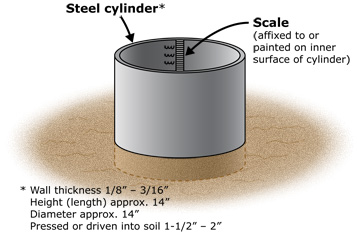- Home
- Learn about salinity
- Get to know your site
- Design a landscape
- Solve a problem
- Other information
Salinity Management Guide
Assessing the movement of water through soil
Measuring the rate of infiltration

The rate of infiltration can be measured with a device known as an infiltrometer. One type is a simple, thin-walled, open-ended steel cylinder measuring 12 to 18 inches in length and 6 to 24 inches in diameter. On the inside of the infiltrometer wall is a graduated scale in millimeters (or in inches plus tenths of inches). The scale should be printed directly on the cylinder wall or made from a separate strip of metal or plastic and spot-welded or glued in place.
You may be able to purchase an infiltrometer of this type; look for one on the Web. Or, one could be fabricated for you. Often, a company that sells steel water pipe can do custom work like this. To find such a company, look in the Yellow Pages or search the Web.
To install the infiltrometer at your site, press it firmly into the soil to a depth of 1 or 1-1/2 inches. If the soil is too dry or for some other reason the infiltrometer ring cannot be pressed into place, tap or pound the ring into the soil with a mallet or hammer, working your way around the rim gradually.
To use the infiltrometer, pour water gently into it until the total depth of water is 6 to 10 inches. Add more water, if needed, so that the level of water is within the upper half of the scale on the cylinder's inner wall. When the level is where you want it to be, stop pouring and take your first reading of the water's level on the scale. Record the time of the reading to the nearest minute.
Once you've begun your measurements, observe the level of water in the infiltrometer for the next 15 minutes or so. If, during that time, the level seems to be falling fairly rapidly, you'll need to remain nearby awhile longer and take additional measurements as the level drops. If, on the other hand, the level of water inside the cylinder falls very slowly or not at all during the first 15 minutes of the test, then it's likely you will be able to go away for several hours or more and return later for additional readings.
For a soil with a very slow rate of infiltration, you may find it sufficient to record the level in the infiltrometer every few hours over several days. If so, you'll need to obtain the local daily evaporation rate. That's because daily evaporative losses must be factored in when calculating the amount of water lost downward into the soil.
Often, a rough estimate of infiltration may be all you need. To obtain such an estimate, simply fill the infiltrometer and then leave for 8 to 10 hours. If, after that interval of time, you find that the water's level hasn't dropped by at least 1 inch, then it's likely you've got a very "slow" soil — that is, a problem may exist regarding movement of water in the soil's upper layers. If, on the other hand, all of the water in the infiltrometer drains out in a few hours (or overnight), you've got a "fast" soil, and drainage issues probably are unlikely.
Rates of infiltration for different types of soil
| Type and texture of soil | Steady infiltration rate, millimeters per hour | Description |
|---|---|---|
| Sand | > 20 | moderate to rapid |
| Sandy and silty soil | 10 – 20 | moderate |
| Loam | 5 – 10 | moderately slow |
| Clayey soil | 1 – 5 | slow |
| Sodic clayey soil | < 1 | very slow |
Adapted from Soil Quality Test Kit Guide, published by the U. S. Department of Agriculture (1999).
A soil's permeability and other such characteristics can vary considerably from one place to another within a landscape, so you should conduct infiltration tests at several locations. Ideally, choose spots that you think will represent the extremes of what you expect to find, as well as a couple of spots that seem to be almost identical. Including the extreme locations in your survey will help to assess the full range of the landscape's soils. Including the locations that seem identical will help to assess the accuracy of the methods and equipment used.
| « Previous page | Next page » |